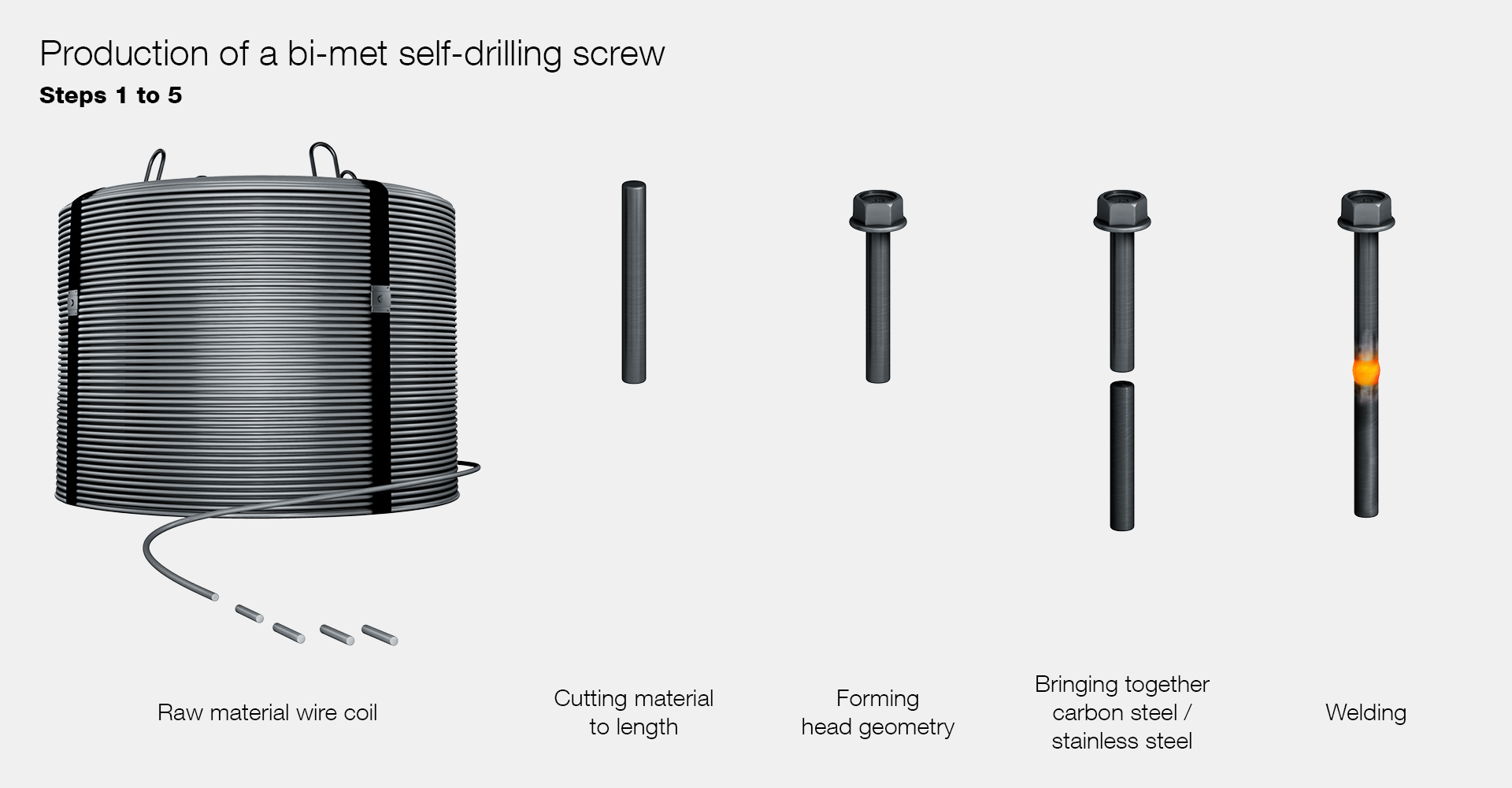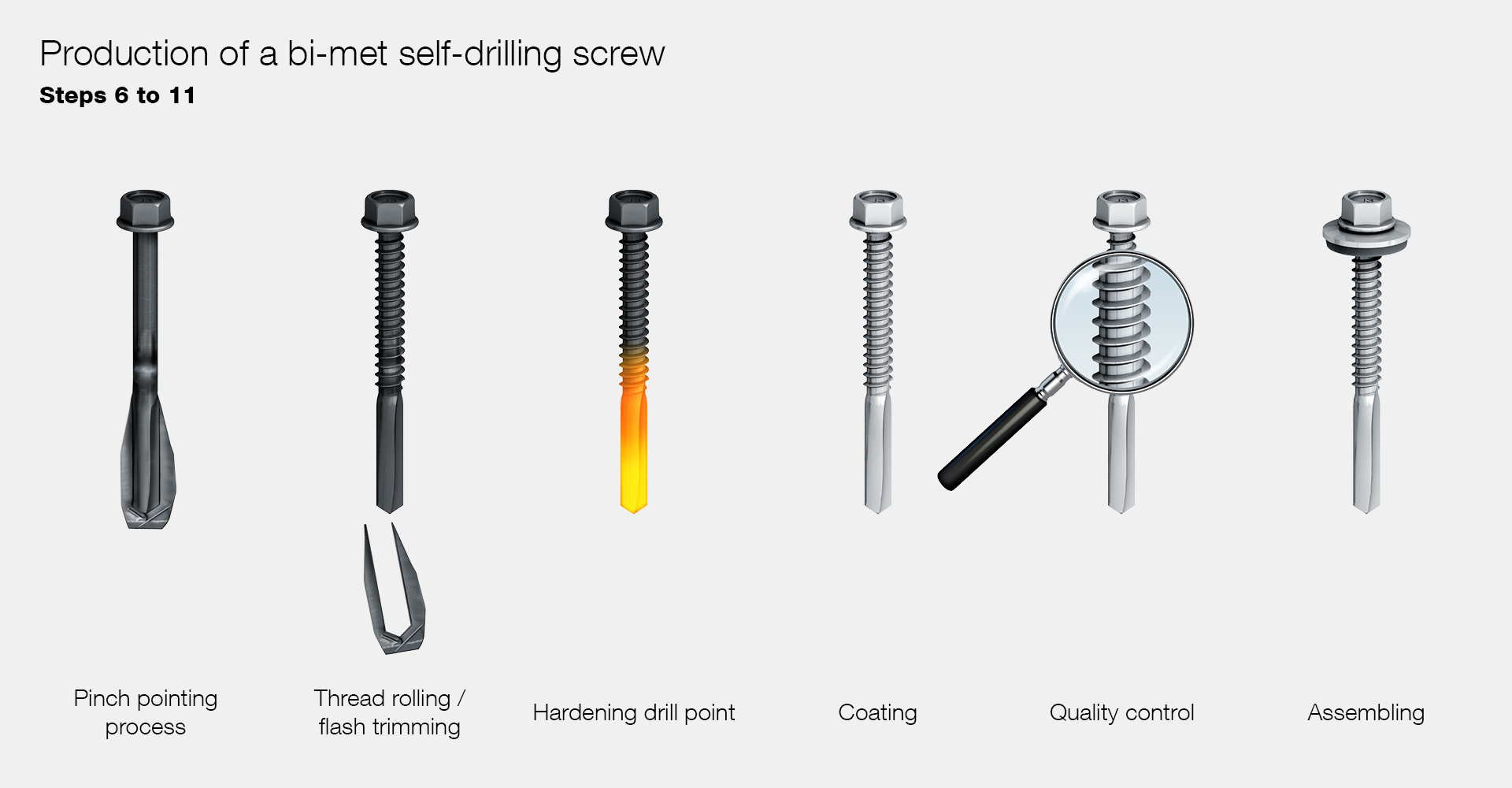Production of self-drilling screws
Guide to self-drilling screws – Part 3
In the first two parts of the self-drilling screw guide, we covered the different types of self-drilling screws as well as the different head styles and drive types.
In this part we would like to show you the basic procedures for screw manufacturing, take you on a journey into the production of EJOT and introduce you to the individual production phases using the example of the EJOT self-drilling screw JT3-18-5.5.Machining productionIn the case of machining (thread cutting), the blank is shaped by milling. The thread is also made this way. The main disadvantage here is the strength of the screws. Machining the blank destroys the grain flow of the raw material, which reduces the load-bearing capacity of the screw.
In this part we would like to show you the basic procedures for screw manufacturing, take you on a journey into the production of EJOT and introduce you to the individual production phases using the example of the EJOT self-drilling screw JT3-18-5.5.
Two manufacturing processes for thread production
First of all, a distinction is made between two different manufacturing processes: machining and forming. Machining plays a rather subordinate role in industrial production It is primarily used for very large screws where the forming process has reached its limits.Machining productionIn the case of machining (thread cutting), the blank is shaped by milling. The thread is also made this way. The main disadvantage here is the strength of the screws. Machining the blank destroys the grain flow of the raw material, which reduces the load-bearing capacity of the screw.
Forming production
Forming production (thread-cutting) is the most common type of screw production. Here, we can differentiate between between cold forming and hot forming. Most manufacturers use the process of cold forming, so we will take a closer look at this process, which we also use at EJOT.The production phases of a bi-met self-drilling screw using the example of the JT3-18-5.5
At the beginning of the screw production, the starting material has the form of wire. This means the heat-treated steel or stainless steel, which is delivered coiled, hence the name coil. First, the wire is cut to the correct length and shaped in this stage as well. This process takes place in several forming stages depending on the head geometry.
The upper part of the bi-met self-drilling screw consists of stainless steel so that it offers an ideal corrosion protection and can be used in weather-exposed areas. The lower part, where the drill point is manufactured later on, is made of carbon steel. The advantage of this material compared to stainless steel is that it can be hardened and is thus able to penetrate steel structures without any difficulty.
In the next production step, the two parts are welded together. The welding process creates the unique material combination of the bi-met self-drilling screws from the corrosion-resistant upper part made of stainless steel and a hardenable drill point area.
The next step is pinch pointing. This is a so-called closed-die forging process that is a type of massive forming process. The typical drill point is formed from the screw blank. After pinch pointing, the next steps are thread-rolling and the removal of slugs, whereby the screw thread is formed on the screw blank. This step represents the last work step for changing the geometry.
In the following hardening process, the bi-met screws are partially hardened. What makes it special: only the area of the drill point is heated and then quenched in a waterbath. This gives the drill point the hardness it needs to penetrate up to 18 mm of construction steel. At the same time, the stainless steel upper part maintains its high corrosion resistance.
The screws are then electroplated and lubricated. The coating serves two purposes: on the one hand, it protects the drill point from corrosion and, on the other hand, this layer structure improves the assembly properties of the self-drilling screw.
Quality controls take place over and over again during the entire manufacturing process. The drilling test is one example of quality control. The screw must drill through a steel test plate, but must not exceed a predefined time. Since cooling lubricants are used again and again during production, the screws are cleaned in special washing systems after the individual work steps.
Once our starting material has passed through all the production steps of the cold forming process, the end result, completed with a sealing washer, is a finished EJOT self-drilling screw in the quality as you know it.
In the following hardening process, the bi-met screws are partially hardened. What makes it special: only the area of the drill point is heated and then quenched in a waterbath. This gives the drill point the hardness it needs to penetrate up to 18 mm of construction steel. At the same time, the stainless steel upper part maintains its high corrosion resistance.
The screws are then electroplated and lubricated. The coating serves two purposes: on the one hand, it protects the drill point from corrosion and, on the other hand, this layer structure improves the assembly properties of the self-drilling screw.
Quality controls take place over and over again during the entire manufacturing process. The drilling test is one example of quality control. The screw must drill through a steel test plate, but must not exceed a predefined time. Since cooling lubricants are used again and again during production, the screws are cleaned in special washing systems after the individual work steps.
Once our starting material has passed through all the production steps of the cold forming process, the end result, completed with a sealing washer, is a finished EJOT self-drilling screw in the quality as you know it.
In this article, we have briefly presented the various methods for producing screws. In practice, thread-cutting has established itself as the most common process, not least because of the better mechanical properties of the end product and the possibility of producing very large quantities per unit of time. In the next part of the self-drilling screw guide, we look at the subject of edge distances and explain what needs to be considered with regard to the various substructures.


